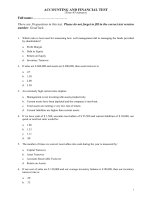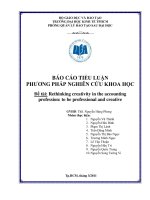KTQTCP_Chap 1_Cost Accounting
Bạn đang xem bản rút gọn của tài liệu. Xem và tải ngay bản đầy đủ của tài liệu tại đây (1.49 MB, 29 trang )
<span class='text_page_counter'>(1)</span><div class='page_container' data-page=1>
<b>WELCOME ABOARD!</b>
<b> />
</div>
<span class='text_page_counter'>(2)</span><div class='page_container' data-page=2>
<b>CONTENT & LEARNING OUTCOMES ASSESSMENT </b>
<b>CONTENT</b>
<sub>Chap 1_Cost Accounting</sub>
<sub>Chap 2_Cost Concepts & Behaviors</sub>
<sub>Chap 6_Fundamentals of Product and Service Costing</sub>
<sub>Chap 7_Job CostingChap </sub>
<sub>8_Process Costing</sub>
<sub>Chap 9_Activity Based Costing</sub>
<b>LEARNING OUTCOMES ASSESSMENT </b>
<sub>Assignments: 20%;</sub>
<sub>Mid-Test: 30%;</sub>
</div>
<span class='text_page_counter'>(3)</span><div class='page_container' data-page=3>
<b>CHAPTER 1: </b>
</div>
<span class='text_page_counter'>(4)</span><div class='page_container' data-page=4>
<b>LEARNING OBJECTIVES</b>
<b>LO1</b>
Describe the way managers use accounting information
to create value in organizations.
<b>LO2 </b>
Distinguish between the uses and users of cost
accounting and financial accounting information.
<b>LO3 </b>
Explain how cost accounting information is used for
decision making and performance evaluation in
organizations.
<b>LO4</b>
Identify current trends in cost accounting.
</div>
<span class='text_page_counter'>(5)</span><div class='page_container' data-page=5>
<b>VALUE CHAIN</b>
Total
amount
that
buyers are willing to
pay
for a firm’s products.
Usefulness
a customer
gains
from a company’s
product or service.
A set of activities that transforms raw
materials and resources into the goods
and services that end users purchase and
consume.
<b> Value added activities: activities that </b>
customers perceive as adding utility to
goods or services they purchase.
<b> Non value-added activities: activities </b>
that do not add value to the good or
service from the customer’s perspective.
<b>Value </b>
<b>Value </b>
<b><sub>Value Chain </sub></b>
<b>Value Chain </b>
</div>
<span class='text_page_counter'>(6)</span><div class='page_container' data-page=6>
<b>Value Chain Components</b>
<b>Research & </b>
<b>Development</b>
<b>Research & </b>
</div>
<span class='text_page_counter'>(7)</span><div class='page_container' data-page=7>
<b>Value Chain Components</b>
support every function of
the value chain,
including:
o Accounting and finance;
o Human resource; and
o Information technology.
<b>Administrative </b>
<b>functions </b>
<b>Administrative </b>
<b>functions </b>
<b> Supply chain includes set of </b>
firms and individuals that sells
goods and services to the firm.
<b> Distribution chain comprises </b>
set of firms and individuals
that buys and distributes
goods and services from the
firm.
<b> Value chain </b>
<b>outside the firm</b>
<b> Value chain </b>
</div>
<span class='text_page_counter'>(8)</span><div class='page_container' data-page=8>
<b>Cost Accounting and the Value Chain</b>
<sub>The measurement and reporting of costs is a </sub>
valuable activity:
<sub>To assist managers in achieving the maximum </sub>
value for their organizations.
<sub>To measure the effects of decisions on the </sub>
value of the organization.
<sub>Cost accounting focuses on how the individual </sub>
</div>
<span class='text_page_counter'>(9)</span><div class='page_container' data-page=9>
<b>ACCOUNTING SYSTEMS</b>
Field of accounting that
reports financial position
and income according to
accounting rules.
Financial data are
governed by GAAP in the
United States and by IFRS
in many other countries.
<b>Financial </b>
<b>accounting</b>
<b>Financial </b>
<b>accounting</b>
Field of accounting that
measures, records, and
reports information about
costs.
Cost data for managerial
use need not comply with
GAAP or IFRS.
<b>Cost </b>
<b>accounting</b>
<b>Cost </b>
<b>accounting</b>
</div>
<span class='text_page_counter'>(10)</span><div class='page_container' data-page=10>
<b>Financial vs. Cost Accounting</b>
</div>
<span class='text_page_counter'>(11)</span><div class='page_container' data-page=11>
<b>Customers of Cost Accounting</b>
<sub>Cost information itself is a product with its own </sub>
customers; the customers are managers.
<sub>Cost accountants must work with managers of cost </sub>
accounting information to provide the best possible
information for managerial purposes.
<sub>Different uses of accounting information require </sub>
</div>
<span class='text_page_counter'>(12)</span><div class='page_container' data-page=12>
<b>FRAMEWORK</b>
<b>FOR ASSESSING COST ACCOUNTING SYSTEMS</b>
<b>0</b>
<b>1</b>
<b>Managers’ Job is to </b>
<b>Make Decisions</b>
<b>0</b>
<b>2</b>
<sub>ASs are a primary source of </sub>
information for managers.
<sub>Concern whether AS </sub>
provides the “best”
information to managers.
<b>Decision Making Requires </b>
<b>Information</b>
<b>0</b>
<b>3</b>
AS can identify costs of none
value-added activities in the value chain.
Managers perform cost-benefit
analyses to assess proposed
changes in an organization
<b>Finding and eliminating </b>
<b>activities that don’t add value</b>
<b>0</b>
<b>4</b>
use the value chain and cost
information to identify strategic
advantages in the market place.
identify activities that customers
value and which the company can
provide at lower cost.
<b>Identifying Strategic </b>
<b>Opportunities Using Cost Analysis</b>
<b>0</b>
<b>5</b>
AS provides information to owners about the performance of theorganization and the manager
</div>
<span class='text_page_counter'>(13)</span><div class='page_container' data-page=13>
<b>COST DATA FOR MANAGERIAL DECISIONS</b>
Costs for
Decision
Making
Costs for
Control and
Evaluation
Different Data
for Different
Decisions
</div>
<span class='text_page_counter'>(14)</span><div class='page_container' data-page=14>
<b>Costs for Decision Making</b>
<b>Example: </b>
Carmen’s Cookies has been making and selling cookies through a small store
downtown. One of her customers suggests that she expand operations and
sell to wholesalers and retailers. Should Carmen expand operations?
Cost
Rent
Insurance
Labor
Ingredients
Driver
Number of stores
Number of cookies
</div>
<span class='text_page_counter'>(15)</span><div class='page_container' data-page=15>
<b>Costs for Decision Making</b>
<b>Carmen’s Cookies</b>
<b>Projected Income Statement for One Week</b>
<b>(1)</b> <b>(2)</b> <b>(3)</b>
<b>Status Quo:</b>
<b>Original Shop</b>
<b>Sales Only</b>
<b>Alternative:</b>
<b>Wholesale & Retail</b>
<b>Distribution</b> <b>Difference</b>
<b>Sales revenue</b> <b>$6,300</b> <b>$8,505a</b> <b><sub>$2,205</sub></b>
<b>Costs:</b> <b> </b>
Food $1,800 2,700b <sub>$900</sub>
Labor $1,000 1,500b <sub>$500</sub>
Utilities $400 600b <sub>$200</sub>
Rent $1,250 1,250
-0-Other $1,000 1,200c <sub>$200</sub>
<b>Total costs</b> <b>$5,450</b> <b>$7,250 </b> <b>$1,800</b>
<b>Operating profits</b> <b>$850</b> <b>$1,255 </b> <b>$405</b>
</div>
<span class='text_page_counter'>(16)</span><div class='page_container' data-page=16>
<b>Costs for Decision Making</b>
When consider two or more alternatives:
<b><sub>Differential costs: costs that differ among or </sub></b>
between alternatives.
<b><sub>Differential revenues: revenues that change in </sub></b>
response to a particular course of action.
To evaluate the financial consequences of alternatives,
<b>estimates of future costs, revenues, and/or assets, using:</b>
<sub>Past information </sub>
</div>
<span class='text_page_counter'>(17)</span><div class='page_container' data-page=17>
<b>Costs for Control and Evaluation</b>
<b>A responsibility center is a specific unit of an </b>
organization assigned to a manager who is held
accountable for its operations and resources.
Organizations divide responsibility for specific functions
among employees.
Functions are grouped into organizational units, called
departments, divisions, segments, or subsidiaries.
</div>
<span class='text_page_counter'>(18)</span><div class='page_container' data-page=18></div>
<span class='text_page_counter'>(19)</span><div class='page_container' data-page=19>
<b>Costs for Control and Evaluation</b>
<b>Budgeting:</b>
<b><sub>Each responsibility center has a budget.</sub></b>
<sub>Helps managers decide whether their goals can be </sub>
achieved and, if not, what modifications are
necessary.
<sub>Managers are responsible for preparing a budget </sub>
and achieving the targets set in the budget.
<b>A budget is a </b>
financial plan of
revenues and
resources needed
to carry out
activities and
meet financial
</div>
<span class='text_page_counter'>(20)</span><div class='page_container' data-page=20>
<b>Costs for Control and Evaluation</b>
<b>Carmen’s Cookies</b>
<b>Retail Responsibility Center</b>
<b>Budgeted versus Actual Costs For the Month Ending April 30</b>
<b>Actual</b> <b>Budget</b> <b>Difference</b>
<b>Food:</b>
Flour $2,100 $2,200 -$100
Eggs $5,200 $4,700 $500
Chocolate $2,000 $1,900 $100
Nuts $2,000 $1,900 $100
Other $2,200 $2,200 $0
<b>Total food</b> <b>$13,500</b> <b>$12,900</b> <b>$600</b>
<b>Labor:</b>
Manager $3,000 $3,000 $0
Other $1,500 $1,500 $0
<b>Total labor</b> <b>$4,500</b> <b>$4,500</b> <b>$0</b>
Utilities $1,800 $1,800 $0
Rent $5,000 $5,000 $0
</div>
<span class='text_page_counter'>(21)</span><div class='page_container' data-page=21>
<b>Different Data for Different Decisions</b>
<sub>One principle of cost accounting is that different </sub>
decisions often require different cost data.
<i><sub>“One size fits all” does not apply to cost accounting.</sub></i>
<sub>Answers some following questions will guide your </sub>
selection of the most appropriate accounting data.
+
<sub>How will the data be used?</sub>
+
<sub>Are they for managers’ use in evaluating </sub>
performance?
</div>
<span class='text_page_counter'>(22)</span><div class='page_container' data-page=22>
<b>TRENDS IN COST ACCOUNTING </b>
<b>THROUGHOUT THE VALUE CHAIN</b>
1.
R&D
2.
Design
3.
Purchasing
4.
Production
5.
Marketing
6.
Distribution
7.
Customer service
<b>ERP </b>
Enterprise
Resource
Planning
Creating
value in the
organization
IT links various
activities into a
single
comprehensive
information
system
All these
tools are
meant to add
</div>
<span class='text_page_counter'>(23)</span><div class='page_container' data-page=23>
<b>Trends in Cost Accounting</b>
Lean manufacturing
techniques are not simply
about production.
Companies partner with
suppliers in the
development stage to
ensure cost-effective
designs for products.
<b>Cost Accounting in</b>
<b> R&D</b>
Product designers must
write detailed specifications
on a product’s design.
This is often referred to as
design for manufacturing
(DFM).
Activity-based costing (ABC)
assigns costs of activities
needed to make a product,
then sums the cost of those
activities to compute the
total cost of the product.
<b>Cost Accounting in </b>
<b>Design</b>
Performance measurement
indicates how well a process
is working.
It minimizes unnecessary
transaction processes.
Benchmarking methods
measure products, services,
and activities against the
best performance.
Benchmarking is an ongoing
process resulting in
continuous improvement.
</div>
<span class='text_page_counter'>(24)</span><div class='page_container' data-page=24>
<b>Trends in Cost Accounting</b>
A lean accounting
system provides
measures at a work
cell or process level.
JIT is an inventory
system designed to
lower the cost of
maintaining excess
inventory.
<b>Cost Accounting in </b>
<b>Production</b>
Customer relationship
management (CRM) is
a system that allows
firms to target
profitable customers
by assessing customer
revenues and costs. .
Harrah’s
Entertainment
provides
“complimentary”
services to some
customers (typically
called “comping”).
<b>Cost Accounting in </b>
<b>Marketing</b>
Outsourcing occurs
when a firm’s activities
are performed by
another organization
or individual in the
supply or distribution
chain.
Nikon, for example,
relies on UPS for
distribution.
<b>Cost Accounting in </b>
<b>Distribution</b>
TQM (Total Quality
Management) is a
management method
which focuses on
excelling in all
dimensions.
The emphasis is placed
on quality. Quality is
defined by the
customer.
Cost of quality is a
system that identifies
the costs of producing
defective items.
</div>
<span class='text_page_counter'>(25)</span><div class='page_container' data-page=25>
<b>Enterprise Resource Planning (ERP)</b>
<b>ERP is the information technology that links the </b>
various systems of the enterprise into a single
comprehensive information system.
Technology
Purchasing
Human
Resources
Marketing
</div>
<span class='text_page_counter'>(26)</span><div class='page_container' data-page=26></div>
<span class='text_page_counter'>(27)</span><div class='page_container' data-page=27>
<b>ETHICAL ISSUES FOR ACCOUNTANTS</b>
The design of the cost accounting system has the
potential to be misused to defraud customers,
employees, or shareholders.
Professional organizations IMA, AICPA have
</div>
<span class='text_page_counter'>(28)</span><div class='page_container' data-page=28>
<b>Ethical Conducts for Accountants</b>
<b>Four ethical </b>
<b>conducts </b>
<b>required by </b>
<b>IMA</b>
</div>
<span class='text_page_counter'>(29)</span><div class='page_container' data-page=29>
<i><b>End of </b></i>
</div>
<!--links-->








